#I had an art exam years ago where we had to draw a live goat's head and the horns were SO tough to depict that I got a headache
Text

Hands down coolest thing I've drawn today, even if the horns are irregular ^^
Buy my autobiography "I find goat skulls and even goats in general very difficult to draw" coming out next never
#while this belongs to an au's design it can perfectly work as normal goatcetamol#goatcetamol lol#I had an art exam years ago where we had to draw a live goat's head and the horns were SO tough to depict that I got a headache#didnt reach those extremes here though I'm miffed my internet isn't working to upload this lol#paracelsus#art tag2b named
10 notes
·
View notes
Text
Summer 2002 Road Trip: Kabul-Kandahar-Herat
Photos and imagery by Fariba Nawa
From the June 2004 issue of Afghan Magazine | Lemar-Aftaab

[caption: Tile work at the Gazargah shrine, Herat province.]
I traveled through Afghanistan in the fall of 2000 during the Taliban era and then returned in 2002 and 2003 to report for various publications and radio programs. These pictures are from the summer of 2002, when I took a cross-country road trip from Kabul, through Kandahar, and then to Herat, my hometown. This was before any roads were repaired, and during a time when many Afghans were still hopeful for change.
As a child, I lived in Kandahar, Helmand, and Herat. Now with American and European journalists as my travel mates, I traced back memories from my childhood, visiting sites like the Helmand River and the Gazergah shrine. I went to schools, shrines, bazaars, and private homes, talking to Afghans from every background and age to gauge the mood of the country.
We took a taxi on the road from Kandahar to Herat. It was a nine-hour ride through a dangerous zone where three people had been killed three days before. Our driver was easy-going, almost fearless, speeding at 90 mph on the cracked roads. We stopped for lunch at a roadside restaurant, and then our driver lit up his usual after-lunch joint. He smoked it as he drove.
My Spanish companion and I were not happy with his dessert. But our German photographer seemed amused. She was sitting in the front and taking photos of him.
"I can drive blindfolded through these roads," he told us with confidence.
Meanwhile, a group of turbaned men with Kalashnikovs jumped out from behind the small hills motioning us to stop with their guns. Our heartbeats accelerated as our car slowed to a stop. I had heard stories of road lootings, but this would be worse. We were all women and foreign women with a lot of cash on hand. We told the driver to keep going. He didn't listen. I somehow felt responsible for these women because I was the Afghan. A thousand things went through my mind. Will they rape us, kills us, and take our money? I clutched onto the door handle as one of the men stuck his head in the window and asked the driver for something in Pashtu.
I can barely understand Pashtu, but I could tell it was about money. We sat motionless, hoping the driver could rescue us. The driver handed the man a 40,000 afghani note, $1 then, said goodbye and drove off. The women looked dumbfounded. I asked the driver what had happened.
"They were just collecting toll. This is how people in this area make their money."
I wasn't sure whether to laugh or cry.
Join me on this journey.
Kabul
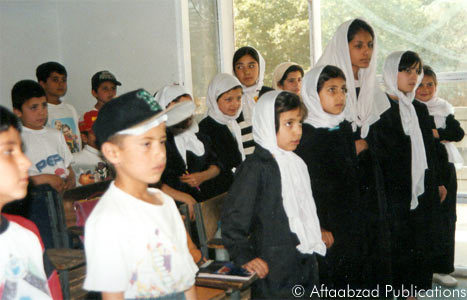
[caption: This is a co-education school in the Kabul neighborhood of Wazir Akbar Khan, which is one of the few areas in the capital left unscathed by war, although it suffers from years of neglect.]

[caption: A young girl gazes at the chalkboard absorbing the day's lessons.]
Kandahar

[caption: A view of the old city in Kandahar. Most Afghan cities and large towns are divided between old and new sections.]

[caption: Children at the Kandahar bazaar. It is common to see small children out alone, running errands for their parents, and taking care of younger siblings.]
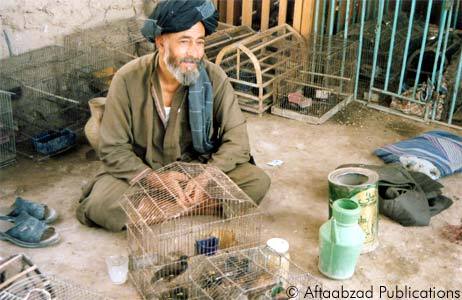
[caption: This bird seller at the Kandahar bazaar sells most of his birds to vendors who make them fight against each other, similar to cockfighting.]

[caption: A young office assistant at the World Food Program. During her downtime, she uses the computer to draw portraits. She wants to be an artist.]
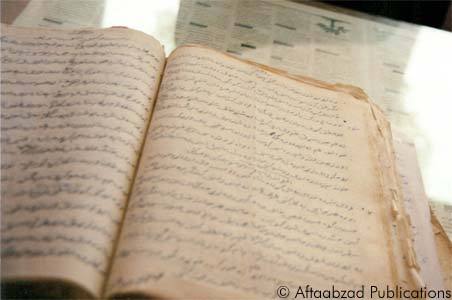
[caption: A 100-year-old Pashtu manuscript brought to the office of Culture and Information for preservation.]
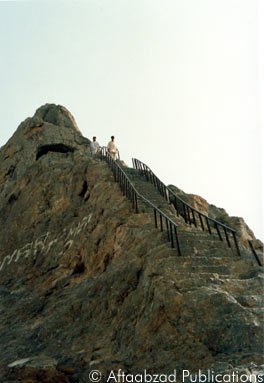
[caption: Located near the old city of Kandahar, the Chihil Zina (Forty Steps) were built in the 16th century by Babur Shah, founder of the Moghul Empire. Inside the cave at the top of the steps, letters carved into the stone pay tribute to Babur Shah. This is one of Kandahar's most treasured historic sites.]
Kandahar to Herat
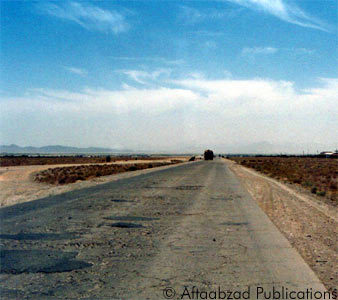
[caption: The bombed-out road from Kandahar to Herat. Drivers speed at 90 mph diving off the path to avoid destroyed bridges and then climbing back up. The drive takes nine hours to reach Herat city after passing three other provinces.]
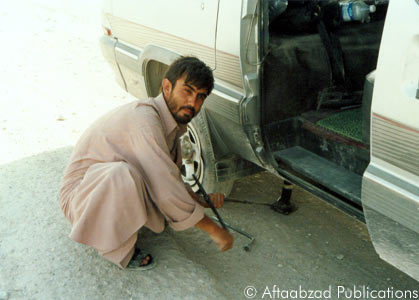
[caption: Nasir, the driver for the Chicago Tribune, changes his seventh tire on the Tunis van. It took us about 17 hours from Kabul to Kandahar on the old, destroyed road. Now that the road has been rebuilt, the trip takes only five hours.]

[caption: Deserted Soviet army barracks. The fields are littered with mines en route to Herat.]

[caption: A taxi driver takes three women journalists, including me, from Kandahar to Herat. He rolls his joint and smokes his daily after-lunch hashish as he drives. "I can drive on this road with my eyes closed. Don't worry," he tells the frightened women.]
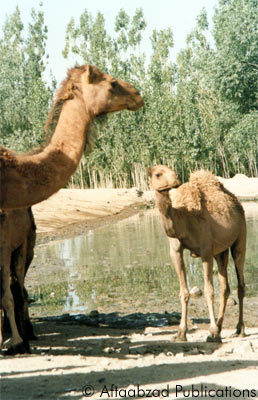
[caption: Camels are still common in rural Afghanistan. Nomads use them for transportation.]
Herat: Historic Sites
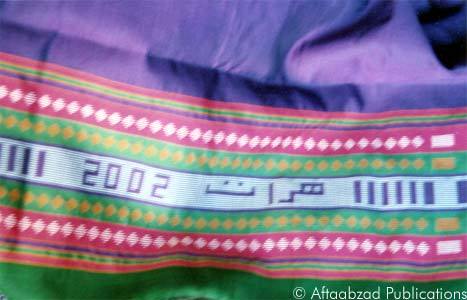
[caption: Around the majestic Friday Mosque in Herat City, men make colorful crafts including handmade silk shawls. This shawl reads "Herat 2002."]

[caption: One of the minarets built in Herat's cultural renaissance in the 15th century during Timurid rule. They encircle the Gowharshad shrine and school, another landmark from the same era.]

[caption: The Friday Mosque (Masjid-e Jami) is a sanctuary for Sufis and vagabonds. It is one of the cleanest public places in the city with gleaming handmade tiles and marble floors. It is among the finest Islamic buildings in the world. The structure is built on the platform of a Fire Temple dating back to the Zoroastrian period.]

[caption: The Friday Mosque's main entrance. The mosque is decorated with beautiful Timurid tilework and calligraphy.]

[caption: Another view of the Friday Mosque.]

[caption: A malang (Sufi wanderer) in a trance at the Friday Mosque.]
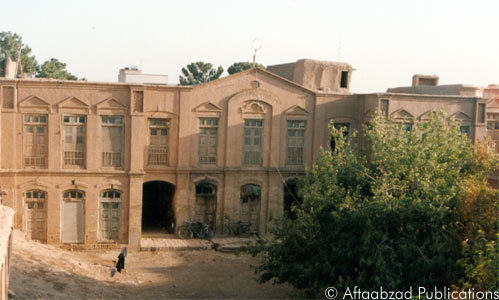
[caption: Near the Friday Mosque are homes from a century ago. The architecture is common to the Islamic world with high ceilings, arches, and fountains in the courtyard. These homes are not being restored. Instead, Afghans are building boxy, whitewashed, modern-style houses modeled after those in Iran.]
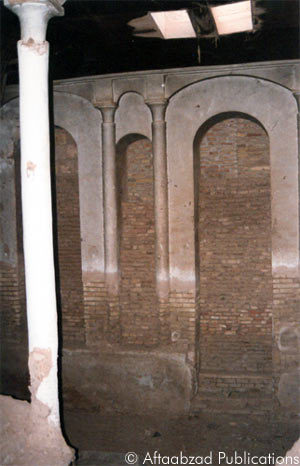
[caption: This was once an indoor pool in one of the old houses.]
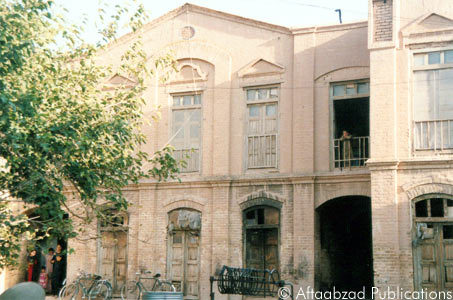
[caption: The family who lives in this house has been here for generations. But they are not sentimental about the fact that they have no running water or electricity.]

[caption: The view of the Friday Mosque from the roof of the old house.]
Herat: Crafts

[caption: In the corridors of the Friday mosque, workers bake and color tiles that will be used for the facades of other buildings in the city.]

[caption: A tile maker designs tiles.]
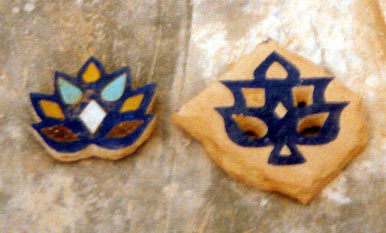
[caption: A finished tile looks something like the flower on the left.]
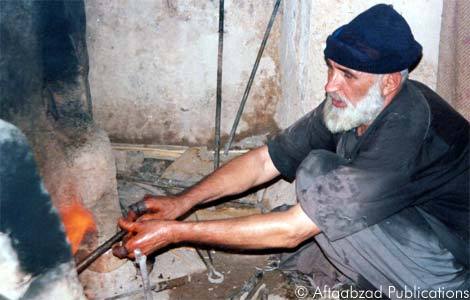
[caption: The glassblower of Herat. He has been blowing blue glass, an authentic Herati craft, for 30 years in front of the Friday Mosque. His young sons aid him in the laborious work, as they endure smoke and 120-degree heat inside a clay hut. "The foreigners come to see how interesting what I do is and how beautiful the glass turns out, but if I could trade this for another job, I'd take it in a second," he says.]
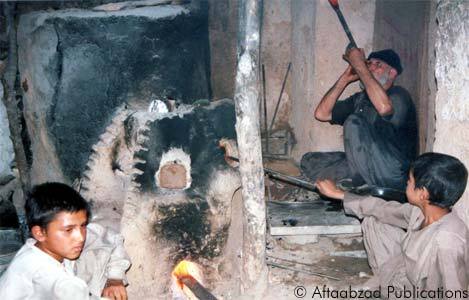
[caption: The father and his sons are busy at work.]

[caption: Designing the glass is a skillful task.]

[caption: Journalist Angeles Espinosa from Spain's premier newspaper El Pais visits the antique shop where the handmade glass is sold.]
Herat: City
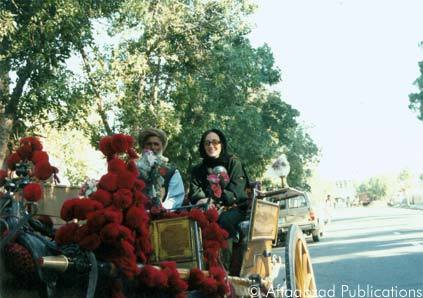
[caption: Riding in a horse wagon is a form of transportation in Herat.]
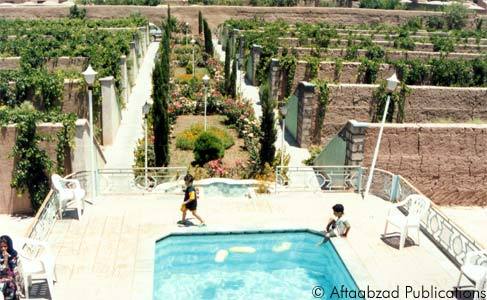
[caption: One of the many sparkling gardens rented out for private family parties on the outskirts of the city. Families gather here on Fridays to picnic and swim.]

[caption: Most homes in Herat have fruit trees and grapevines. Families pluck their dessert right from their yards.]
Herat: Education
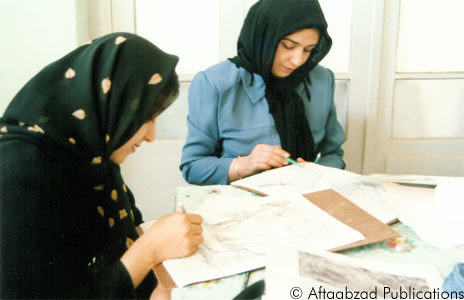
[caption: Students at the Fine Arts College at Herat University. The classes are segregated by gender, but men and women study at the same university.]
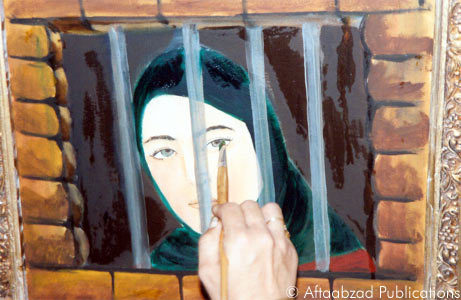
[caption: Roia Hamid, a 26-year-old recent graduate of the Fine Arts College at Herat University, draws the image of a woman behind bars. Tears drip down from the sky to her face. "This is how I felt when the Taliban ruled here," Hamid says.]
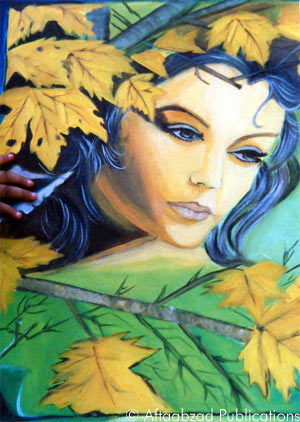
[caption: Hamid's paintings. She copied this from a book lying around in her house.]

[caption: One of the students displays his work in the classroom. The men and women of the Fine Arts College organized a gallery exhibit. Some pieces sold for more than $1,000. The students are influenced by many art schools, including the classical school of Behzad, the 15th century Herati artist who established a unique style of miniature painting, often referred to as the "Rafael of the East".]

[caption: Young girls in school in uniform. At their age, a burka is not necessary.]
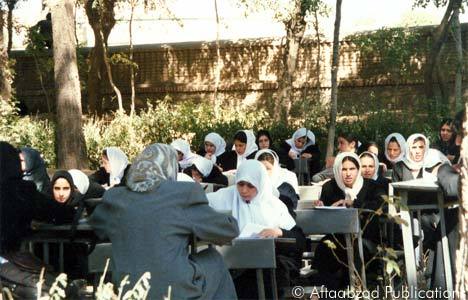
[caption: Classrooms in high schools are so full that students have to sit outside for exams. This group of girls is taking a geography test.]
Herat: Country and Camps
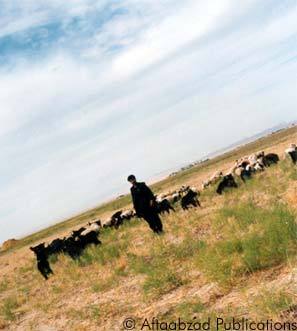
[caption: Ishaq Norzi, an Afghan who lives in Iran, visits his family land in Ghorian, a village two hours from Herat city.]
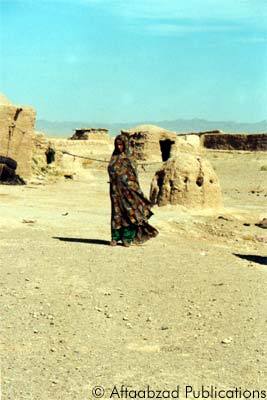
[caption: A young woman in Ghorian village, one of the most devastated areas in the province. It's one of the drug trafficking routes to Iran and the men and women in Ghorian live on the drug trade. This woman is an opium addict living in a clay hut in the desert.]
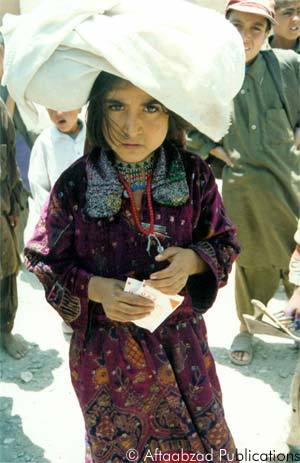
[caption: A young girl at the internally displaced refugee camp of Maslakh carries bread on her head. Many of the camps inside the country are closing as people return to their homes, but Maslakh remains open for the most down and out refugees.]
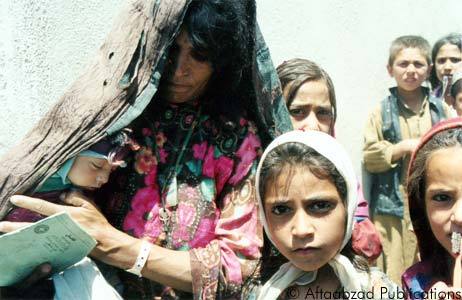
[caption: A mother and infant stand in line to see the camp doctor. Camp residents suffer from cholera, malaria, diarrhea, typhoid, and many other diseases. Ailments in the West that are easily treated become a death sentence to many in Afghanistan who have limited access to health care.]

[caption: The camp bazaar. Refugees find innovative merchandise to sell from sweets to blankets.]
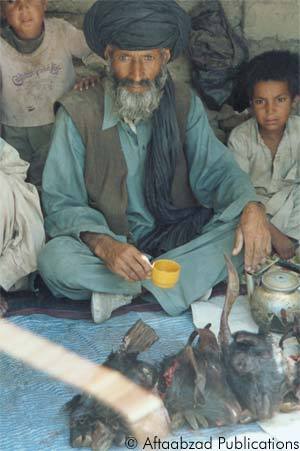
[caption: Goat heads or is it sheep?]
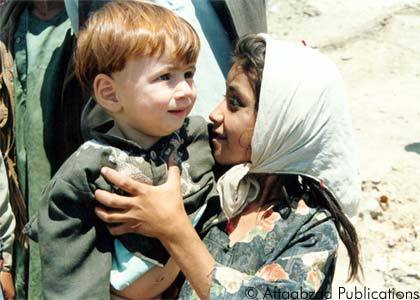
[caption: Young girls take care of their younger siblings as if they are the mothers.]

[caption: Some girls shy away from the camera; others own it with their smile.]

[caption: Maslakh's brightest smiles and its hope.]
Herat: Gazargah

[caption: It is an honor to be buried in the cemetery next to the Gazergah shrine, located 3 miles east of Herat city. The 15th century Timurid ruler Shah Rukh built the complex of buildings around the shrine.]
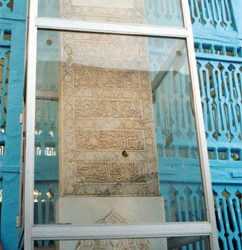
[caption: The Gazergah shrine of Khoja Abdullah Ansary, the renowned 11th-century Sufi poet. Afghans from every walk of life gather here to pray and give alms. The shrine and its surrounding cemetery, mosque, and garden belong to the Mir family, descendants of the poet.]
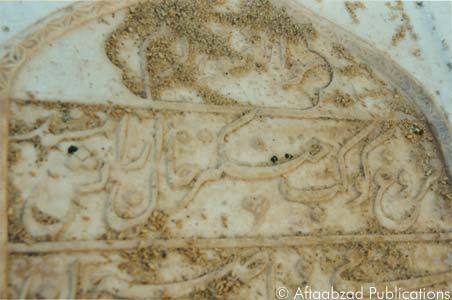
[caption: Centuries-old Persian calligraphy remains on the walls of the shrine.]
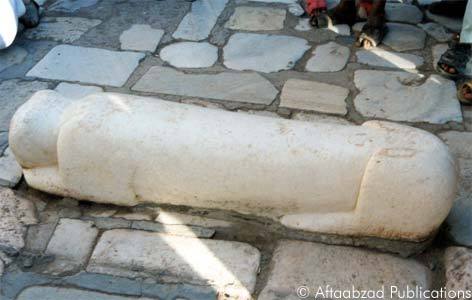
[caption: The gatekeepers of the shrine hid this statue of a lying dog from the Taliban. The architect who built the shrine represented himself as a dog to show his loyalty to the great poet, Ansary.]
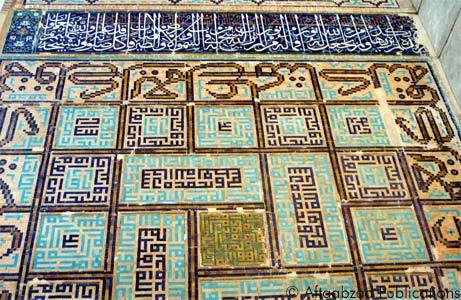
[caption: Lavishly decorated tile work at the shrine.]
About Fariba Nawa فریبا نوا
Fariba Nawa, an award-winning Afghan-American journalist, covers a range of issues and specializes in women’s rights and conflict zones. She is based in Istanbul, Turkey and has traveled extensively to the Middle East, Central and South Asia. Visit Her Website
1 note
·
View note